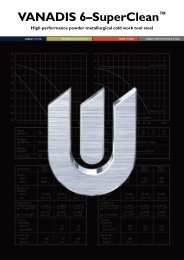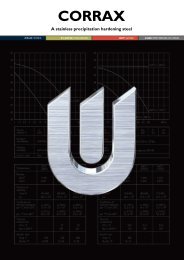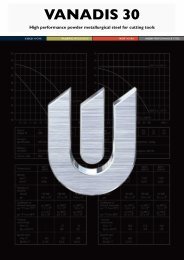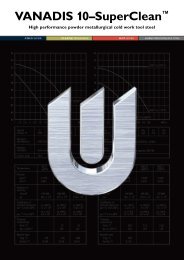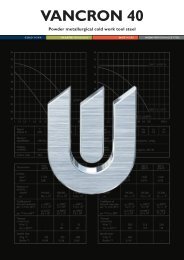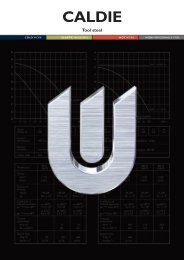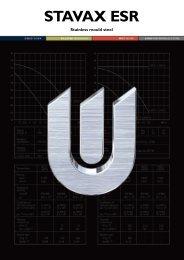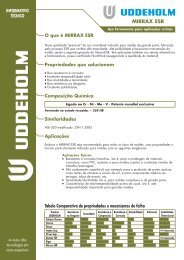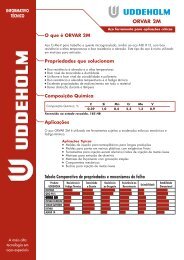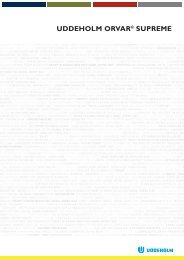THG 2000 eng-03 - Uddeholm
THG 2000 eng-03 - Uddeholm
THG 2000 eng-03 - Uddeholm
You also want an ePaper? Increase the reach of your titles
YUMPU automatically turns print PDFs into web optimized ePapers that Google loves.
<strong>THG</strong> <strong>2000</strong><br />
Edition 3, 11.20<strong>03</strong><br />
Ref. No. <strong>03</strong>1107<br />
High-str<strong>eng</strong>th special steel<br />
with good machining properties for demanding applications
<strong>THG</strong> <strong>2000</strong><br />
General<br />
<strong>THG</strong> <strong>2000</strong> is a chromium-molybdenum-vanadiumalloy<br />
steel developed for such applications as<br />
indexable insert drill and milling cutter bodies.<br />
<strong>THG</strong> <strong>2000</strong> is available in soft annealed and prehardened<br />
condition.<br />
Its main features are:<br />
• Good resistance to abrasion at both low and<br />
high temperatures<br />
• Good toughness and ductility<br />
• Good high-temperature str<strong>eng</strong>th and resistance<br />
to thermal fatigue<br />
• Good through-hardening characteristics and<br />
suitability for air hardening<br />
•Very little distortion during hardening.<br />
Compared with a normal tool steel, the machinability<br />
is improved, which facilitates such operations<br />
as drilling and tapping small holes. It is particularly<br />
suitable for induction-hardening, and can also be<br />
given a PVD coating without reducing the hardness<br />
of the tool.<br />
Typical C Si Mn Cr Mo V<br />
analysis % 0,39 1,0 0,4 5,3 1,3 0,9<br />
Delivery Prehardened 41–45 HRC<br />
condition Soft annealed to approx. 185 HB<br />
Colour code Yellow/violet – soft annealed<br />
Violet/grey – prehardened<br />
Applications<br />
<strong>THG</strong> <strong>2000</strong> is a high-str<strong>eng</strong>th special steel, intended<br />
for applications with severe demands on the<br />
mechanical properties of the material, while also<br />
requiring good machinability.<br />
Examples of applications are:<br />
• Indexable insert drills and milling cutters<br />
• Milling chucks and tool tapers<br />
• Highly stressed drive shafts and transmission<br />
parts for motor vehicles<br />
• Rolls in continuous casting machines<br />
• Clamp jaws<br />
• Conveyor rollers for carrying hot parts.<br />
Properties<br />
PHYSICAL DATA<br />
Hardened and tempered to 45 HRC.<br />
Data at room temperature and at elevated temperatures.<br />
Temperature 20°C 400°C 600°C<br />
(68°F) (750°F) (1110°F)<br />
Density<br />
kg/m 3 7800 7700 7600<br />
lbs/in 3 0,281 0,277 0,274<br />
Modulus of elasticity<br />
N/mm 2 210 000 180 000 140 000<br />
psi 30,3 x 10 6 26,1 x 10 6 20,3 x 10 6<br />
Coefficient of<br />
thermal expansion<br />
per °C from 20°C – 12,6 x 10 –6 13,2 x 10 –6<br />
per °F from 68°F – 7,0 x 10 –6 7,3 x 10 –6<br />
Coefficient of<br />
thermal conductivity<br />
W/m °C – 29 30<br />
Btu in/(ft 2 h°F) – 204 211<br />
MECHANICAL PROPERTIES<br />
Approximate tensile str<strong>eng</strong>th at room temperature.<br />
Hardness 52 HRC 45 HRC<br />
Ultimate tensile<br />
str<strong>eng</strong>th, Rm<br />
N/mm 2 1820 1420<br />
kp/mm 2 185 145<br />
tsi 117 92<br />
psi 263 000 206 000<br />
Yield str<strong>eng</strong>th, Rp0,2<br />
N/mm 2 1520 1280<br />
kp/mm 2 155 130<br />
tsi 98 83<br />
psi 220 000 185 000<br />
Effect of hardening time on hardness at elevated<br />
temperatures<br />
Hardness, HRC<br />
50<br />
45<br />
500°C (930°F)<br />
40<br />
35<br />
550°C (1020°F)<br />
30<br />
600°C (1110°F)<br />
25<br />
Indexable insert drills, manufactured from <strong>THG</strong> <strong>2000</strong>.<br />
650°C (1200°F)<br />
20<br />
1 10 100 1000<br />
Time, hours<br />
2
<strong>THG</strong> <strong>2000</strong><br />
Str<strong>eng</strong>th at elevated temperatures<br />
Longitudinal direction.<br />
psi<br />
1000x<br />
290<br />
261<br />
232<br />
2<strong>03</strong><br />
174<br />
145<br />
116<br />
87<br />
58<br />
29<br />
Rm, Rp0,2<br />
MPa (N/mm 2 )<br />
<strong>2000</strong><br />
1800<br />
1600<br />
1400<br />
1200<br />
1000<br />
800<br />
600<br />
400<br />
200<br />
Rp0,2<br />
Z<br />
Rm<br />
A5,<br />
Z %<br />
100<br />
90<br />
80<br />
70<br />
60<br />
50<br />
40<br />
30<br />
20<br />
10<br />
100 200 300 400 500 600 700 °C<br />
210 390 570 750 930 1110 1290 °F<br />
Test temperature<br />
A5<br />
HARDENING<br />
Preheating temperature: 600–850°C (1110–1560°F).<br />
Austenitizing temperature: 900–1<strong>03</strong>0°C (1650–<br />
1890°F), normally 1020°C (1870°F).<br />
Temperature Soaking time* Hardness before<br />
°C °F minutes tempering<br />
900 1650 45 44 ±3 HRC<br />
920 1690 45 46 ±3 HRC<br />
940 1720 45 47 ±3 HRC<br />
960 1760 45 48 ±3 HRC<br />
980 1800 45 50 ±3 HRC<br />
1000 1830 45 52 ±3 HRC<br />
1020 1870 30 53 ±3 HRC<br />
* Soaking time = time at specified temperature after the part is<br />
fully heated through.<br />
Protect the part from decarburization during<br />
hardening.<br />
Heat treatment<br />
SOFT ANNEALING<br />
Protect the steel against decarburization and heat it<br />
through to 850°C (1560°F). Allow it to cool in the<br />
furnace at a rate of 10°C per hour to 650°C<br />
(1200°F), and then freely in air.<br />
STRESS RELIEVING<br />
After rough machining it is recommended to do a<br />
stress relieving, the part shall then be heated<br />
through to 650°C (1200°F), and held at this<br />
temperature for two hours. Cool slowly to 500°C<br />
(930°F), and then freely in air.<br />
QUENCHING MEDIA<br />
• Circulating air or atmosphere<br />
•Vacuum furnace (with sufficient positive pressure)<br />
• Martempering bath or fluidized bed at 180–<br />
220°C (350–430°F), or at 450–550°C (840–<br />
1020°F), followed by cooling in air<br />
• Hot oil 60–70°C (140–160°F).<br />
Note: Temper the part as soon as its temperature<br />
has fallen to 50–70°C (120–160°F).<br />
TEMPERING<br />
Choose the tempering temperature to suit the hardness<br />
required by reference to the diagram below.<br />
Temper twice, with intermediate cooling to room<br />
temperature. The minimum tempering temperature<br />
is 180°C (360°F). The holding time at the relevant<br />
temperature shall be at least 2 hours.<br />
Tempering graph<br />
Hardness, HRC<br />
55<br />
50<br />
45<br />
40<br />
960°C<br />
(1760°F)<br />
900°C<br />
(1650°F)<br />
1020°C<br />
(1870°F)<br />
980°C<br />
(1800°F)<br />
35<br />
30<br />
A tool holder for an end mill made of <strong>THG</strong> <strong>2000</strong>.<br />
25<br />
250 300 350 400 450 500 550 600 650 °C<br />
480 570 660 750 840 930 1020 1110 1200 °F<br />
Tempering temperature<br />
3
<strong>THG</strong> <strong>2000</strong><br />
Tempering within the range 425–525°C (800–<br />
980°F) is not normally recommended, due to the<br />
fact that toughness properties are degraded in this<br />
temperature range.<br />
DIMENSIONAL CHANGES DURING HARDENING<br />
Test plate size 100 x 100 x 25 mm<br />
Width L<strong>eng</strong>th Thickness<br />
% % %<br />
Oil-hardened from<br />
1020°C (1868°F) min. –0,08 –0,06 0,00<br />
max. –0,15 –0,16 +0,30<br />
Air-hardened from<br />
1020°C (1868°F) min. –0,02 –0,05 –<br />
max. +0,<strong>03</strong> +0,02 +0,05<br />
Vacuum-hardened from<br />
1020°C (1868°F) min. +0,01 –0,02 +0,08<br />
max. +0,02 –0,04 +0,12<br />
DIMENSIONAL CHANGES DURING TEMPERING<br />
Dimensional changes %<br />
+0,12<br />
+0,08<br />
+0,04<br />
0<br />
–0,04<br />
–0,08<br />
–0,12<br />
100 200 300 400 500 600 700 °C<br />
210 390 570 750 930 1110 1290 °F<br />
Tempering temperature (1h + 1h)<br />
Note: The dimensional changes occurring during<br />
hardening and tempering are cumulative.<br />
CASE HARDENING<br />
Case hardening increases the surface hardness and<br />
wear resistance of the steel, increases its resistance<br />
to bending and twisting and improves the fatigue<br />
str<strong>eng</strong>th.<br />
<strong>THG</strong> <strong>2000</strong> can be case hardened as follows:<br />
Carburization temperature: 900°C (1650°F)<br />
Austenitizing temperature: 980°C (1795°F)<br />
Cooling: in air or oil<br />
Tempering: 250°C (480°F) twice, or 525°C<br />
(980°F) twice.<br />
Surface hardness: 58 ±3 HRC.<br />
NITRIDING<br />
Nitriding produces a hard surface layer which is very<br />
resistant to wear and erosion. However, the nitrided<br />
layer is brittle and can crack or spall if exposed to<br />
mechanical or thermal shock, with the risk increasing<br />
with layer thickness. Before nitriding, the part<br />
must be hardened and tempered at a temperature<br />
at least 50°C ( 90°F) above the nitriding temperature.<br />
Nitriding in ammonia at 510°C (950°F), or plasma<br />
nitriding at 480°C (896°F) in a 25% nitrogen—<br />
75% hydrogen mixture, can both produce a surface<br />
hardness of about 1100 HV 0,2 . In general, plasma<br />
nitriding is to be preferred, as it provides better<br />
control of the nitrogen potential. In particular, it<br />
avoids formation of the “white layer”, although gas<br />
nitriding can give perfectly acceptable results.<br />
<strong>THG</strong> <strong>2000</strong> can also be nitro-carburized in gas or salt<br />
baths, to produce a surface hardness of 900–<br />
1000 HV 0,2 .<br />
NITRIDING DEPTH<br />
Time Nitriding depth<br />
Process hours mm inch<br />
Gas nitriding 10 0,12 0,005<br />
at 510°C (950°F) 30 0,20 0,008<br />
Plasma nitriding 10 0,12 0,005<br />
at 480°C (896°F) 30 0,18 0,007<br />
Nitrocarburizing<br />
– in gas at<br />
580°C (1076°F) 2,5 0,11 0,004<br />
– in salt bath at<br />
580°C (1076°F) 1 0,06 0,002<br />
Nitriding to case depths more than 0,3 mm<br />
(0,012 inch) is not recommended for components<br />
intended for high-temperature applications.<br />
<strong>THG</strong> <strong>2000</strong> can also be nitrided in the soft-annealed<br />
condition, although its hardness and case depth will<br />
be somewhat reduced.<br />
Case hardening depth<br />
Carburizing time<br />
approx.<br />
mm inch<br />
2 hours ~0,35 ~0,014<br />
4 hours ~0,65 ~0,025<br />
16 hours ~1,30 ~0,051<br />
Use a mild carburization material.<br />
<strong>THG</strong> <strong>2000</strong> is a suitable material for various types of milling<br />
cutter bodies.<br />
4
<strong>THG</strong> <strong>2000</strong><br />
Cutting data<br />
recommendations<br />
The cutting data below for <strong>THG</strong> <strong>2000</strong> should be<br />
regarded as guide values, which should be modified<br />
in the light of experience to suit specific local conditions.<br />
For more detailed information, see <strong>Uddeholm</strong><br />
brochure “Cutting data recommendations ”.<br />
Soft annealed condition: ~185 HB<br />
TURNING<br />
Turning<br />
with carbide<br />
Turning<br />
with high<br />
speed steel<br />
Cutting data Rough Fine Fine<br />
parameters turning turning turning<br />
Cutting speed (v c )<br />
m/min 210–260 260–310 30–35<br />
f.p.m. 690–860 860–1020 100–115<br />
Feed (f)<br />
mm/r 0,2–0,4 0,05–0,2 0,05–0,3<br />
i.p.r 0,008–0,016 0,002–0,008 0,002–0,012<br />
Depth of cut (a p )<br />
mm 2–4 0,5–2 0,5–3<br />
inch 0,08–0,16 0,02–0,08 0,02–0,12<br />
Tool grade P10–P15 P10 –<br />
Coated<br />
carbide<br />
DRILLING<br />
High speed steel twist drill<br />
Coated<br />
carbide or<br />
cermet<br />
MILLING<br />
Face and square shoulder milling<br />
Milling with carbide<br />
Cutting data<br />
parameter Rough milling Fine milling<br />
Cutting speed (v c )<br />
m/min 200–260 260–300<br />
f.p.m. 660–860 860–990<br />
Feed (f z )<br />
mm/tooth 0,2–0,4 0,1–0,2<br />
inch/tooth 0,008–0,016 0,004–0,008<br />
Depth of cut (a p )<br />
mm 2–5 –2<br />
inch 0,08–0,2 –0,08<br />
Tool grade P20–P40 P10–P20<br />
Coated carbide Coated carbide<br />
or cermet<br />
End milling<br />
Type of end mill<br />
Carbide<br />
Cutting data Solid indexable High<br />
parameters carbide insert speed steel<br />
Cutting<br />
speed, (v c )<br />
m/min 150–200 160–210 40–45 1)<br />
f.p.m. 495–660 530–690 130–148<br />
Feed (f z )<br />
mm/tooth 0,<strong>03</strong>–0,20 2) 0,08–0,20 2) 0,05–0,35 2)<br />
inch/tooth 0,0012–0,008 0,0<strong>03</strong>–0,008 0,002–0,014<br />
Tool grade ”Micrograin” P20–P30 –<br />
Coated Coated<br />
carbide carbide<br />
1)<br />
For coated HSS end mill v c = 50–60 m/min. (165–200 f.p.m.)<br />
2)<br />
Depending on radial depth of cut and cutter diameter.<br />
Drill diameter Ø Cutting speed (v c ) Feed (f)<br />
mm inch m/min f.p.m. mm/r i.p.r.<br />
–5 –3/16 25–30* 82–100* 0,08–0,20 0,0<strong>03</strong>–0,008<br />
5–10 3/16–3/8 25–30* 82–100* 0,20–0,30 0,008–0,012<br />
10–15 3/8–5/8 25–30* 82–100* 0,30–0,35 0,012–0,014<br />
15–20 5/8–3/4 25–30* 82–100* 0,35–0,40 0,014–0,016<br />
*For coated HSS drill v c = 35 m/min. (115 f.p.m).<br />
Carbide drill<br />
Type of drill<br />
Cutting data Indexable Solid Brazed<br />
parameters insert carbide carbide 1)<br />
Cutting<br />
speed , (v c )<br />
m/min 220–240 130–160 80–110<br />
f.p.m. 725–790 430–530 265–360<br />
Feed (f)<br />
mm/r 0,06–0,15 2) 0,08–0,30 2) 0,15–0,25 2)<br />
i.p.r. 0,002–0,006 0,0<strong>03</strong>–0,012 0,006–0,01<br />
1)<br />
Drill with internal cooling channels and brazed carbide tip.<br />
2)<br />
Depending on drill diameter.<br />
5
<strong>THG</strong> <strong>2000</strong><br />
Cutting data recommendations for<br />
<strong>THG</strong> <strong>2000</strong> in prehardened condition<br />
41–45 HRC<br />
TURNING<br />
Turning with carbide<br />
Cutting data<br />
parameters Rough turning Fine turning<br />
Cutting speed (v c )<br />
m/min 60–80 80–100<br />
f.p.m. 200–260 260–330<br />
Feed (f)<br />
mm/r 0,2–0,4 0,05–0,2<br />
i.p.r 0,008–0,016 0,002–0,008<br />
Depth of cut (a p )<br />
mm 2–4 0,5–2<br />
inch 0,08–0,16 0,02–0,08<br />
Tool grade P10–P15 P10<br />
Coated carbide Coated carbide<br />
or cermet or<br />
mixed carbide<br />
DRILLING<br />
TiCN-coated high speed steel drill<br />
Drill diameter Ø Cutting speed (v c ) Feed (f)<br />
mm inch m/min f.p.m. mm/r i.p.r.<br />
–5 –3/16 10–15 33–50 0,<strong>03</strong>–0,15 0,001–0,006<br />
5–10 3/16–3/8 10–15 33–50 0,15–0,20 0,006–0,008<br />
10–15 3/8–5/8 10–15 33–50 0,20–0,25 0,008–0,01<br />
15–20 5/8–3/4 10–15 33–50 0,25–0,30 0,01–0,012<br />
Carbide drill<br />
Type of drill<br />
Cutting data Indexable Solid Brazed<br />
parameters insert carbide carbide 1)<br />
Cutting<br />
speed , (v c )<br />
m/min 90–110 80–100 50–60<br />
f.p.m. 300–360 260–330 165–200<br />
Feed (f)<br />
mm/r 0,05–0,10 2) 0,05–0,15 2) 0,10–0,15 2)<br />
i.p.r 0,002–0,004 0,002–0,006 0,004–0,006<br />
1)<br />
Drill with internal cooling channels and brazed carbide tip.<br />
2)<br />
Depending on drill diameter.<br />
MILLING<br />
Face and square shoulder milling<br />
Milling with carbide<br />
Cutting data<br />
parameter Rough milling Fine milling<br />
Cutting speed (v c )<br />
m/min 40–50 50–70<br />
f.p.m. 130–165 165–230<br />
Feed (f z )<br />
mm/tooth 0,15–0,25 0,10–0,20<br />
inch/tooth 0,006–0,01 0,004–0,008<br />
Depth of cut (a p )<br />
mm 2–4 –2<br />
inch 0,08–0,16 –0,08<br />
Tool grade P20–P40 P10–P20<br />
Uncoated carbide Coated carbide<br />
or cermet<br />
End milling<br />
Type of end mill<br />
Carbide<br />
Cutting data Solid indexable High<br />
parameters carbide insert speed steel<br />
Cutting<br />
speed, (v c )<br />
m/min 80–100 80–100 8–10<br />
f.p.m. 260–330 260–330 26–33<br />
Feed (f z )<br />
mm/tooth 0,<strong>03</strong>–0,15 1) 0,08–0,15 1) 0,05–0,20 1)<br />
inch/tooth 0,0012–0,006 0,0<strong>03</strong>–0,006 0,002–0,008<br />
Tool grade ”Micrograin” P15–P30 TiCN-coated<br />
Coated Coated HSS mill<br />
carbide carbide<br />
1)<br />
Depending on radial depth of cut and cutter diameter.<br />
A transmission part manufactured from <strong>THG</strong> <strong>2000</strong>,<br />
hardened to 45 HRC.<br />
6
<strong>THG</strong> <strong>2000</strong><br />
GRINDING<br />
A general grinding wheel recommendations is given<br />
below. More information can be found in the<br />
<strong>Uddeholm</strong> brochure “Grinding of Tool Steel”.<br />
Wheel recommendation<br />
Soft annealed Hardened<br />
Type of grinding condition condition<br />
Face grinding<br />
straight wheel A 46 HV A 46 GV<br />
Face grinding segments A 24 GV A 36 GV<br />
Cylindrical grinding A 46 LV A 60 JV<br />
Internal grinding A 46 JV A 60 IV<br />
Profile grinding A 100 LV A 120 JV<br />
Electrical-discharge<br />
machining, EDM<br />
If spark-erosion is performed in the hardened and<br />
tempered condition, the white re-cast layer should<br />
be removed mechanically e.g. by grinding or stoning.<br />
The tool should then be given an additional<br />
temper at approx. 25°C (50°F) below the previous<br />
tempering temperature.<br />
Hard-chromium plating<br />
After plating, parts should be tempered at 180°C<br />
(360°F) for 4 hours to avoid the risk of hydrogen<br />
embrittlement.<br />
Welding<br />
Welding of <strong>THG</strong> <strong>2000</strong> can be performed with good<br />
results if proper precautions are taken regarding<br />
elevated temperature, joint preparation, choice of<br />
consumables and welding procedure.<br />
Welding method TIG MMA<br />
Working 325–375°C 325–375°C<br />
temperature 620–710°F 620–710°F<br />
Filler metal QRO 90 TIG-WELD QRO 90 WELD<br />
Hardness after<br />
welding 48–51 HRC 48–51 HRC<br />
Heat treatment after welding<br />
Hardened<br />
Temper at 20°C (40°F) below the<br />
condition<br />
original tempering temperature.<br />
Soft annealed Soft-anneal the material at 850°C<br />
condition<br />
(1560°F) in protected atmosphere.<br />
Then cool in the furnace at 10°C<br />
(20°F) per hour to 650°C (1200°F)<br />
then freely in air.<br />
More detailed information can be found in the<br />
<strong>Uddeholm</strong> brochure ”Welding of Tool Steel”.<br />
Further information<br />
Please, contact your local <strong>Uddeholm</strong> office for<br />
further information on the selection, heat treatment,<br />
application and availability of <strong>Uddeholm</strong> tool steels.<br />
The combination of good high-temperature str<strong>eng</strong>th, wear<br />
resistance and good machining properties make <strong>THG</strong> <strong>2000</strong><br />
suitable for use as rolls in continuous casting machines.<br />
This information is based on our present state of knowledge and is<br />
intended to provide general notes on our products and their uses. It should<br />
not therefore be construed as a warranty of specific properties of the<br />
products described or a warranty for fitness for a particular purpose.<br />
7



